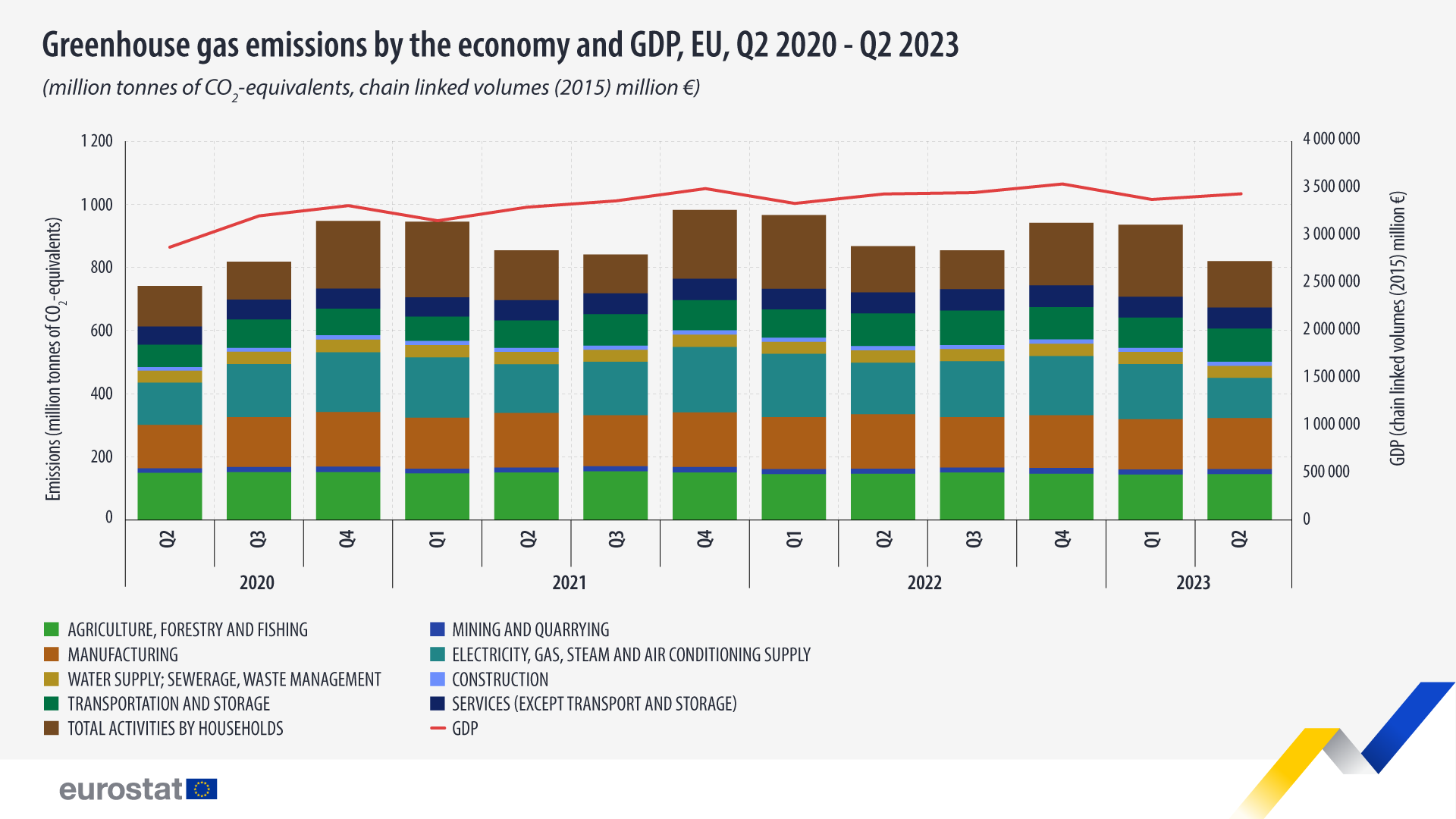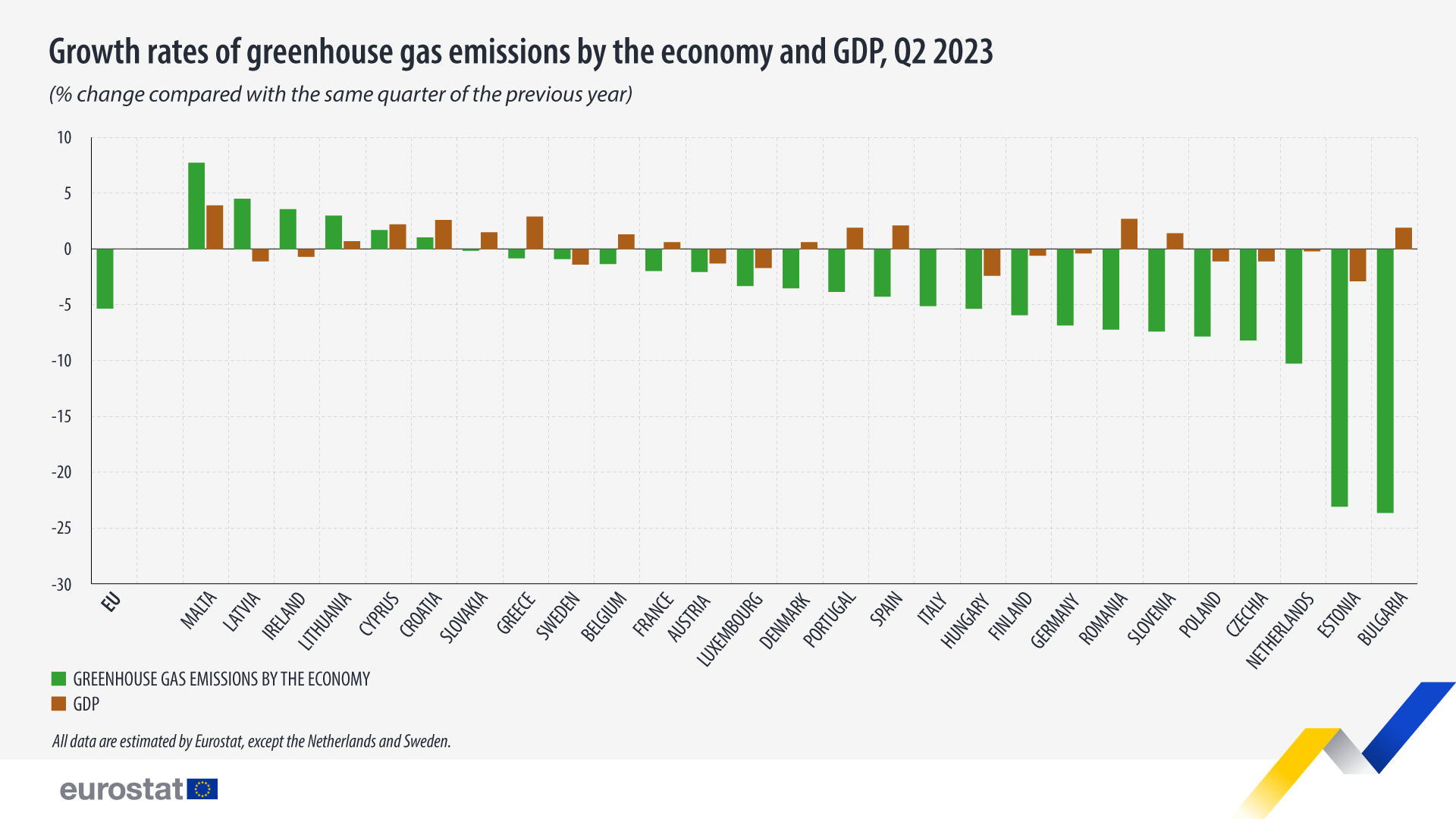EU economy greenhouse gas emissions: -5.3% in Q2 2023
.jpg)
In the second quarter of 2023, EU economy greenhouse gas emissions totalled 821 million tonnes of CO2-equivalents (CO2-eq), a -5.3% decrease compared with the same quarter of 2022 (867 million tonnes of CO2-eq). In the same period, the EU’s gross domestic product (GDP) remained stable registering just a very small variation (+0.05% in the second quarter of 2023, compared with the same quarter of 2022).
This information comes from data on quarterly estimates for greenhouse gas emissions by economic activity published by Eurostat today. Quarterly estimates of greenhouse gas emissions complement quarterly socio-economic data, such as GDP or employment. This article presents a handful of findings from the more detailed Statistics Explained article on quarterly greenhouse gas emissions.
Source dataset: env_ac_aigg_q and namq_10_gdp
In the second quarter of 2023, the economic sectors responsible for most greenhouse gas emissions were manufacturing (23.5%), households (17.9%), electricity, gas supply (15.5%), agriculture (14.3%), followed by transportation and storage (12.8%).
Compared with the second quarter of 2022, emissions decreased in 6 out of 9 economic sectors. The biggest decrease was registered in ‘electricity, gas supply’ (-22.0%). The main sector in which emissions increased was ‘transportation and storage’ (+1.7%).
Greenhouse gas emissions down in 21 EU countries
In the second quarter of 2023, greenhouse gas emissions decreased in 21 EU countries, when compared with the second quarter of 2022. Increases were registered in Malta (+7.7%), Latvia (+4.5%), Ireland (+3.6%), Lithuania (+3.0%), Cyprus (+1.7%) and Croatia (+1.0%). Among these six EU members, four had a GDP increase: Malta (+3.9%), Croatia (+2.6%), Cyprus (+2.2%) and Lithuania (+0.7%).
The largest reductions in greenhouse gases were registered in Bulgaria (-23.7%), Estonia (-23.1%) and the Netherlands (-10.3%).
Source dataset: env_ac_aigg_q and namq_10_gdp
Out of the 21 EU members that decreased their emissions, 10 recorded a decline in their GDP (Estonia, Hungary, Luxembourg, Sweden, Austria, Czechia, Poland, Finland, Germany and the Netherlands). Italy maintained its GDP at the same level as the second quarter of 2022 and decreased its GHG emissions. Ten EU countries (Denmark, France, Belgium, Slovenia, Slovakia, Bulgaria, Portugal, Spain, Romania and Greece) managed to decrease emissions while growing their GDP.
For more information
- Statistics Explained article on quarterly greenhouse gas emissions
- Thematic section on climate change
- Database on climate change
- Overview of the key types of greenhouse (GHG) emission estimates that are regularly published by bodies of the European Union (EU), including the EU inventory and the EU annual climate progress report, including inventory emissions for Member States, published annually in the fourth quarter.
Methodological notes
- Metadata on quarterly greenhouse gas emissions
- Greenhouse gases cause climate change. The so-called ‘Kyoto basket’ of greenhouse gases includes carbon dioxide (CO2), methane (CH4), nitrous oxide (N2O) and fluorinated gases. They are expressed in a common unit, CO2-equivalents, as defined in the IPCC Fifth Assessment Report (AR5).
- The data presented here are estimates by Eurostat, except for the Netherlands and Sweden, which provided their own estimates. Eurostat’s methodology differs from the monitoring and reporting of greenhouse gas emissions under the UN rules, which provides annual data on EU progress towards its targets. A main methodological difference is an attribution to individual countries of international transport and the corresponding air emissions. The Eurostat estimates include the international transport emissions in the total for each country, according to the international System of Environmental-Economic Accounting (SEEA).
- The EU inventory is based on annual inventory reports by the Member States and is prepared and quality checked by the European Environment Agency on behalf of the Commission and submitted to the UNFCCC each spring. The period covered by the inventory starts in 1990 and runs up until 2 years before the current year (e.g., in 2021 the inventories cover greenhouse gas emissions up to 2019). According to the European Climate Law, the EU’s climate target is to achieve a -55% net reduction by 2030 and climate neutrality by 2050.
- EU countries are required to monitor their emissions under reporting rules based on internationally agreed obligations in line with guidelines from the IPCC. The reporting covers emissions of seven greenhouse gases from all sectors: energy, industrial processes, land use, land use change & forestry (LULUCF), waste, agriculture, etc. As parties to the UNFCCC and the Paris Agreement, the EU and Member States report annually on their greenhouse gas emissions to the UN ('greenhouse gas inventories').
If you have any queries, please visit our contact us page.


